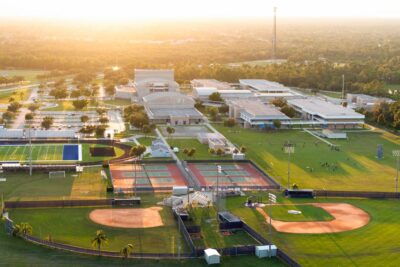Higher ed’s demographic future
A conversation with Dr. Nathan Grawe
March 8, 2021, By Sally Amoruso, Chief Partner Officer
Dr. Nathan Grawe, author of Demographics and the Demand for Higher Education, recently sat down with EAB’s Chief Partner Officer Sally Amoruso to discuss his follow-up book The Agile College. The two discuss how COVID has impacted Grawe’s forecasts plus insights from proactive institutions grappling with the effects of demographic change.
In his original book, Grawe projected that the Northeast and Midwest regions would lose five percent of their college-aged populations by the mid-2020s. He estimated that by 2026, when the effects of the birth decline due to the Great Recession reached college campuses, the number of college-aged students would drop almost 15%. These projections led to significant work on many campuses to secure their enrollment pipelines and combat the inevitable market change.
(Note: The interview below has been edited for length and clarity by Kristina Azevedo)
SA: What prompted you to do a refresh so soon after that first blockbuster book? What changed and what has remained the same since your first book was released in 2018?
NG: Most of the motivation came from how institutions are responding to the demographic fertility cliff. I talked to college administrators all over the country about how they were adapting. My goal was to collect stories and spark conversations about what tactics institutions were using to adapt to the new demographic reality.
The second book starts with an updated forecast because there’s value in asking: “If we push a little further into the 2030s, what happens as we see the effects of the demographic fertility cliff in the present?” In my first book, the projections end in 2029, but this new book goes into the mid-2030s, which gives us more clarity as we see trends unfold. Most of my projections remained consistent, but I found that the projections weren’t as tough as I initially thought for the elite and two-year institutions.
SA: Your more recent projections indicate that the number of non-Hispanic Black students will decline at all institutions, while Asian and Hispanic students represent most of the growth. How would you counsel institutions that are creating programs to increase the diversity of their student populations?
NG: This is a projection based on past behaviors; It’s the path we are on now but it’s not what has to happen. We have seen a decline in the number of African American babies which is a part of this story, but higher ed can’t do anything about that. Still, when we think about the college going rates we’ve seen since the financial crisis, the rates among African American high school graduates have declined, which is worrisome.
However, we can look at the Hispanic subpopulation and see some reason for hope. What had been an enormous gap in college going rates turned into no gap at all in about 2016. My first thought was, Well, Hispanics disproportionately attend two-year schools. Is this just a surge of two-year attendance? No, the surge is in four-year attendance particularly among publics-but also among privates. This is a reminder that what has been in the past does not have to be the same in the future.
SA: We’re looking at 3 million students missing from the public school system, disproportionately students of color. This is forcing us to re-conceive the concept of college readiness. How can we be ready for students with different levels of academic preparedness?
NG: On one hand, we need to have standards. On the other hand, what is it that we are trying to do? There are a lot of problems in K-12 that higher ed can’t directly solve. At the same time there are workforce needs. Higher ed sits in the middle of those two. We can say, “Well those students don’t have the skills that I’m willing to work with.” But then we become a clog in the pipeline.
Alternatively, we can say, “Where are you at?” when evaluating prospective students’ college readiness. We may be disappointed with the answer, but we can still engage with students where they are, take them to the next level, and ultimately serve both ends of the pipeline. If students aren’t prepared for our curriculum, then we need to change our curriculum and be flexible with how we get them onto the on-ramp to a higher ed degree.
SA: You started this work before COVID hit. How has COVID accelerated a lot of the pressures that you had already projected in 2018?
NG: Just stepping back a little bit, COVID breaks my projections if they’re predicated on patterns that we saw in 2013. That raises questions about what happens next. The bottom line is that this is outside of the model. According to work at the Brookings Institution, COVID might cost us an additional 300,000 – 500,000 babies, which will be difficult for higher ed starting in the mid-2030s.
In the short run, we are looking at scarcity– we’re trying to grapple with having fewer students who are willing and able to come to our campuses in the short run. That’s forced us to think about things like student success, student-centered advising, and student-centered retention initiatives-all of which have the greatest promise in the long run.
SA: There is significant legislation under consideration that could impact higher ed. What is the potential impact of the Biden administration?
NG: I think it’s too soon to say at the institution level.
I get anxious when people talk about forgiveness of student loans because that is going to be regressive on average. Most people who have student loans are people who have degrees and higher incomes. The challenge is really among people who drop out and have loans, but no ability to pay them. The crisis is more about an alignment of payments with income. I think these broad brush responses will send a lot of money out the door, but it will not be very well targeted.
When we think about free college at two-year institutions, we’re worried that people might attend colleges with lower retention rates.
For example, in Tennessee, there’s evidence to suggest that the free college program draws students out of the regional four-year privates and into two-years. I don’t know if that’s really the answer because we have to acknowledge that while 80% of two-year college enrollees think they want a four-year degree, only about 20% actually transfer within six years. If these programs draw students away from high success areas to lower success areas, then we need to get the student success rates up in two-year schools.
SA: Let’s talk about the adult learner and how you see that as an opportunity for our institutions.
NG: Institutions struggling to enroll traditional students may try to diversify and the potential there is huge. What if we were actively engaged in the lifelong learning of 150 million people in the labor market? It wouldn’t take very much in terms of penetration of that market. If you could just get one percent more adults in the labor force to re-engage with higher ed, you would resolve a lot of the issues with lagging enrollment.
However, institutions that just do some cheap advertising to adult learners might get an initial payoff, but it won’t be sustainable because adult learners will figure out that institutions are not really transforming who they are to meet their needs. The institutions that succeed will be the ones that put in the work.
SA: I’m watching disruptors like Grow with Google and other non-degree based credentials that may fill in that space between the B.A. and non-B.A. What do you think about that and how that might impact the projections moving forward?
NG: I’ve heard from a number of higher ed leaders who say that we have to figure out how to play nicely with corporate America and be the solution to their problem. They need highly skilled labor, people who can do the job. They don’t necessarily need credentials. There’s a lot of pressure because if we can’t figure out how to be their solution, then we will be competitors.
SA: A theme that has run through this whole conversation is workforce alignment and workforce readiness. Yet for many liberal arts colleges, some faculty have had an allergic reaction to really embracing that as part of the mission. Do you think that’s going to start to shift?
NG: It’s critical that we teach students how to learn and think for themselves, rather than memorize specific information. While I remain committed to this liberal arts philosophy, the Great Recession moved a lot of faculty members to recognize we must help students see connections between their studies and the lives and careers they will lead after graduation.

More Blogs

3 strategies for leading your university through unprecedented change

Beyond ROI: What the New Fed Data Misses About Higher Ed’s Value Crisis
